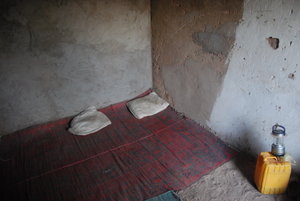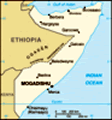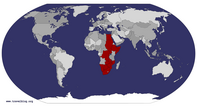Advertisement
Published: January 28th 2010

 Bed
Bed
Managed a mighty one hour here on the way to HargeisaYes that's right. Somalia. The most dangerous country on the planet. Well, sort of. The international image of Somalia is one giant boomerang shaped basket case populated by a cast of ruthless buccaneers - Treasure Island or Pirates of the Caribbean it certainly ain’t. My advance research on the FCO webpage makes for grim reading. However, the country is actually three states in one. Somalia main in the south: the Somalia of your nightmares. Above it the equally anarchic separatist state of Puntland, which occupies the tip of Africa's Horn. Finally, to the west of this, another breakaway fledgling nation, Somaliland (formerly British Somaliland before Somalia's independence). Of the three, only Somaliland is accessible to travellers retaining their sanity. It is still a little dangerous; in 2003 Somali insurgents crossed the border and shot a number of aid workers. Then in late 2008 three bombs were detonated in Somaliland's capital, Hargeisa. Again foreigners were targeted. On my final full day there is news of a bombing in one of the outlying towns, Las Anod. Kidnappings are a regional hobby. Yet because Somaliland is not internationally recognised (a gripe which the local media harp on about just a little bit) it is
desperate for favourable reports from tourists to boost its image and credibility abroad. Therefore the safety of foreigners is taken very seriously. An armed escort is mandatory for any excursions outside the capital, although ironically this hinders tourism because of the cost. Not that many people come here anyway. My visa is number 450 issued since the start of 2009 and the country averages between one and two tourists per day. To put this into context, Egypt receives around 10 million tourists per year.
The most testing part of my brief trip to Somaliland is getting there. It is without question the toughest, most physically demanding single journey I have ever endured. Despite booking a place early on one of the handful of battle scarred 4WDs that are the only land transport between Djibouti City and Hargeisa, R and I get relegated to the back. For the first hour, until the border, this takes the form of a cramped, slanted bench and is just about manageable. For the remaining 15 hours on the Somaliland side, where we swap vehicles, the previous level of discomfort is remembered with longing affection. There are no seats now. Only the floor of
a large boot space, covered in a slippery mat with various lumpy objects underneath (I'm allocated some rope and a pair wellington boots for my submerged "cushion"), itself covered in a layer of scratchy sand that ravages my bare feet. For company back here I am blessed with a sleeping Singaporean - don't ask me how he does it - and two Somalis with knife sharp knees.
The "road", if it merits such a classification, is truly atrocious. For most of the way we are travelling at night, in order to avoid the formidable daytime temperatures of the region, which makes our driver's ability to navigate this vast and repetitive terrain all the more impressive. At many points the track disappears altogether and we appear to be blasting blindly across the open, scrubby desert. How we repeatedly re-emerge onto the path, after it seems to have escaped forever into the blackness, I have no idea. Not that driving along this road is something to be grateful for. Some of the potholes are large enough to conceal and entire armada's worth of pirates. The only way to tackle them is flat out, slowly circumventing them would otherwise turn a
journey of many hours into one of many days. There are no useful hand holds to grip from where I sit and for much of the time I am flung about like a ragdoll with alarming violence. At no point does the unrepentantly brutal ground relent. I am exhausted and very very sore when we finally reach Hargeisa late the next morning.
The lack of tourists in Somaliland means we are quite an attraction here. Unlike Djibouti, where the beggars skipped R and went straight for the white man, "China" is the star here. This call rings out wherever we go. Even when I explore alone it is barked at me and I'm unsure whether people are simply unaware of the difference between us or want to know what I've done with their beloved, exotic Asian. The place offers a strange mix of conservatism and conviviality. I see more burqas than in either Egypt or Sudan yet the women are far more physically playful and tomboyish than any seen before. I am even able to talk to some and a couple consent to my photographing the exquisitely elaborate henna that decorates their hands and forearms, an act which

 Hard fought freedom
Hard fought freedom
Decoration on the war memorialinstantly draws a large crowd. I do get shouted at aggressively on occasion but this is rare. My only moment of conflict comes in the market where, having just photographed some henna and consequently brimming with confidence, I get out my camera and ask one woman if I can snap her resplendent crop of tomatoes. Her response is to shoo me away and her neighbours then begin to pelt me with their tomatoes. The produce is clearly of an excellent quality as they all firmly bounce off. Aside from this, the overwhelming majority of people are welcoming and we are greeted with genuine warmth by someone seemingly every few metres as we stroll about. Many stop to engage us in conversation and I am impressed with the level of English across all age ranges.
We reserve one full day to visit Somaliland's main tourist attraction; Las Geel. To visit we require a permit so head over to the tourist ministry, where it is also comparatively cheap to organise a car and obligatory protection. The Minister for Tourism is a friendly guy and we have tea with him while hanging around. He throws in an English speaking guide for
free and I am shocked when this newcomer greets me with a cheeky "How you doing mate?" in a crisp West London accent. Our guide it seems is one of the many Somalis - a naturally nomadic people whose migratory tendencies have only been exaggerated by the wretched state of most of the country - who have drifted abroad in recent generations. He has family living in Kensington and it’s great to chat and joke fluently in this way with a local. He has the amusing habit of throwing in English colloquialism while talking in Somali, but I've noticed this trait among a number of others as well. We pick up an AK sporting soldier and must part with $20 more than expected for an invisible second chaperone. Apparently it should be one guard per foreigner but as there is not enough room in our car the authorities are willing to fudge the paperwork and save us hiring a second vehicle. Obviously we are less than pleased about paying this hidden cost for an equally hidden service, but there's not much we can do and the overly mothering nature of the security forces here does actually make the one to

 Taking tea with the minister
Taking tea with the minister
The Somaliland Minster of Tourismone ratio seem a plausible reason to relieve us of more cash. Before we leave the city, our guard insists on making a stop for qat and promptly begins to chomp away until he is happily stoned and of absolutely no use should any actual danger befall us.
Were Las Geel in any other country it would undoubtedly be snapped up as a UNESCO World Heritage site. Surrounded by fields of quartz, it is essentially a large rocky outcrop in the desert containing a series of cave paintings; predominantly human, canine and bovine. Little is known about these mystical pieces of art, though they have been fairly accurately dated back to somewhere between 5000 and 3000BC. Their meaning is unclear as is the means of their production. The colours of some are still vivid and when the local tribes were asked to replicate the paint used, their attempts faded out of existence within two years. There is something magical about standing beneath these awakenings of mankind’s creative consciousness. Afterwards we look in the tiny information centre, containing half a dozen placards of simple text. The building has no key and the curator must open it by fiddling around
with a twig in the hole once occupied by a door handle. The guest book, the size of an A4 pad of paper, dates back to 2005 - the site was discovered at the end of 2002 - yet is only half full. Afterwards we speed back towards Hargeisa, but the few short kilometres of off road between the main road and the site have proved too much for our beleaguered vehicle, which patently isn't designed for such hardship. By the time we reach the outer perimeter of the city our back right tyre is completely flat. We stop to change it but typically the spare does not fit (having a different number of bolt holes that I would’ve thought should have been obvious at time of purchase!). The team's answer is to just hang around in the hope that someone will pass with both air and a pump. Eventually, following an unsurprising lack of success with this strategy, we are fortunate that a late afternoon bus passes and we can catch a ride back into the centre.
I spend one more day after our Las Geel trip continuing to explore the streets of Hargeisa then we decide
to head back into Ethiopia as the clock is ticking for both of us and I want to conserve my precious cash dollars, which are needed to acquire the large bundles of Somali Shillings which are needed for even the smallest purchase here. The road out is tarmacked for part of the way. Although my map suggests we should have followed this for the last stretch from Djibouti City we most certainly didn't and I'm now convinced that our journey here was a direct 'shortcut' across the desert. As we approach the border the road becomes merely a field of dust, which swirls in giant clouds all around. The border is typically basic - just a couple of immigration shacks - and soon we are back, safe and sound, in Ethiopia.
Advertisement
Tot: 0.106s; Tpl: 0.013s; cc: 21; qc: 101; dbt: 0.0731s; 1; m:domysql w:travelblog (10.17.0.13); sld: 1;
; mem: 1.4mb























Cessna152
Jason Smart
A fantastic read! A place I'd never imagine reading a blog about. And your writing style is witty, articulate and informative. (And that photo of the $20 with the pile of Somalian currency is great!) Well done. I'm going to read a few more of your blogs and subscribe to the rest of them